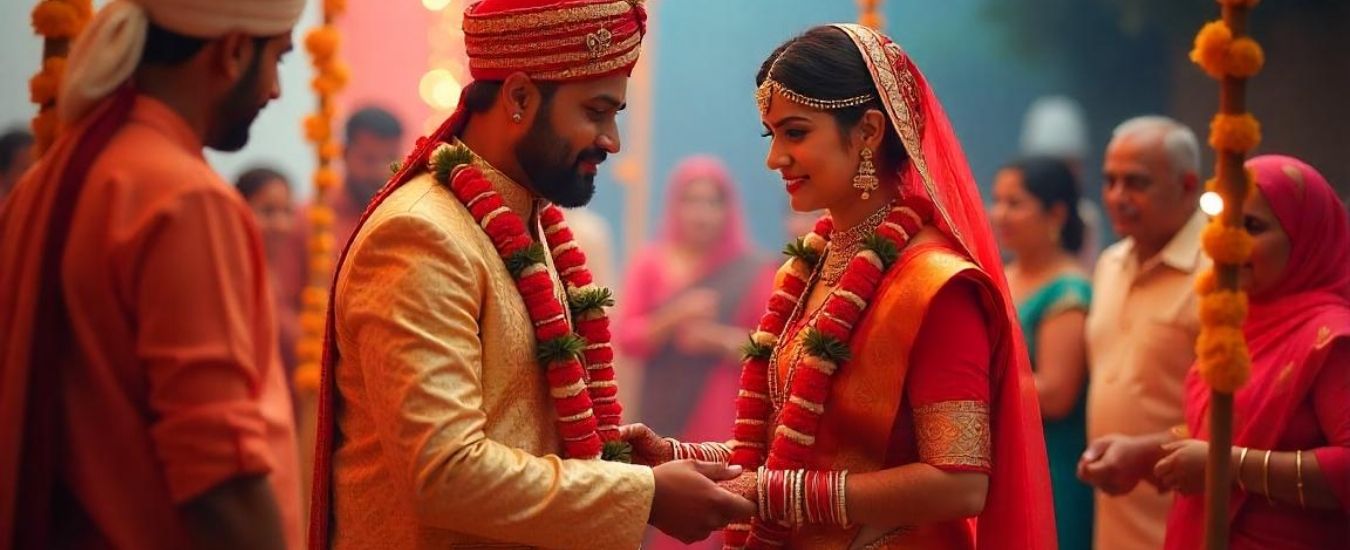Sindhi weddings are a blend of cultural wedding traditions, joy, and unbreakable family ties. Through every ritual—from matchmaking to the reception—the celebration of love and community shines.
A Glimpse into Sindhi Marriage & Culture and Matrimonial Customs
Sindhi culture, rooted in the ancient Sindh region, is known for its warmth, hospitality, and vibrant Indian matrimonial customs. At the heart of every traditional Indian wedding, especially a Sindhi wedding lies a seamless blend of spirituality, community, and celebration.
What Makes Sindhi Weddings Unique?
Sindhi marriage ceremonies stand apart with their strong cultural backbone, colourful décor, joyful rituals, and the unmistakable presence of Jhulelal Worship, the community’s revered deity. Unlike some other wedding rituals in India, they carry both Hindu religious elements and unique Sindhi customs.
Pre-Wedding Ceremonies
- Kacchi Misri: A preliminary meeting symbolizing mutual agreement featuring the exchange of sweets.
- Pakki Misri: A more formal engagement with gifts, clothes, and Laghu rituals.
- Berana Satsang: Devotional songs are sung in honour of Jhulelal for blessings on the couple.
- Dev Bithana: The deity is installed ceremoniously in the home to guide the union.
- Lada: A joyful night of traditional Sindhi folk songs sung mostly by women.
Engagement and Ceremonies Before the Big Day
- Tih (Engagement): Marked by symbolic gifts from the groom’s side. In some families, the Lagna Patrika (auspicious wedding date invitation) is also shared.
- Mehendi Ceremony: The bride’s hands and feet are decorated with henna amidst singing and pampering.
- Saanth Ceremony: A cleansing ritual involving oil massage and turmeric paste, offering spiritual and physical purification.
- Sagri and Sangeet: Sagri involves flower adornment and blessings; Sangeet is a fun-filled night of music and dance.
Unique Rituals You Might Not Know
- Rukh Ceremony: Involves the bride’s family visiting the groom’s house and offering gifts before the wedding.
- Hathleva: A pre-wedding ritual where the couple’s hands are tied together as a symbol of unity.
- Thaal Ceremony: A ceremonial welcome where a decorated plate (thaal) filled with rice and diya is used for blessings.
Wedding Day Celebrations
- Baraat: The groom arrives dancing to the beats of dhol and traditional music, often adorned in a Sindhi Sehra (ornamental headgear).
- Palla Ceremony: The bride’s dupatta is tied to the groom’s shawl.
- Kanyadaan and Phere: Vedic mantras are recited, and the couple takes seven rounds around the sacred fire.
- Saptapadi and Mangalsutra: The couple prays for a happy life while the groom ties the mangalsutra, symbolizing their eternal bond.
Post-Wedding Traditions
- Datar: Bride enters her new home and is fed milk with sugar or kheer, symbolizing sweetness.
- Gadjani: An emotional farewell for the bride from her family.
- Reception: The groom’s family hosts a celebration with food and music to welcome the bride.
Symbolism in Sindhi Matrimonial Traditions
- Fire and Water: Representing purity and life.
- Sacred Threads and Wedding Garlands: Symbolize connection, blessings, and fertility.
- Offerings like coconut, rice, and flowers reinforce the sanctity of the bond.
Wedding Attire and Accessories
- Sindhi Bridal Makeup includes bold eye makeup, red bindi, and borla.
- The bride wears a red or maroon lehenga, while the groom sports a sherwani with a cane or sword for elegance.
Cuisine and Celebrations
- Traditional Sindhi Dishes: Sai Bhaji, Sindhi Curry, Koki, Sindhi Biryani, and Besan Papdi.
- Sweet Treats: Mitho Lolo, Seero, Malpua.
- Wedding Food Rituals also include offering food to deities before serving.
Music and Modern Vibes
- Dance floors buzz with folk beats, modern DJ tracks, and family performances.
- Fusion weddings today incorporate destination settings, designer wear, and Sindhi-themed digital invitations.
FAQs
How long do Sindhi wedding celebrations last?
Sindhi weddings typically span 3 to 5 days, including all pre-wedding and post-wedding rituals.
What is the significance of Misri in Sindhi engagements?
Misri symbolizes sweetness and happiness in the couple’s upcoming life together. It’s a central part of the engagement rituals.
Do Hindu traditions influence Sindhi weddings?
Yes, Sindhi weddings are deeply rooted in Hindu traditions but also incorporate regional and cultural elements unique to the Sindhi community.
Is the Mangalsutra ceremony part of Sindhi weddings?
Absolutely! The groom ties the Mangalsutra around the bride’s neck as a symbol of their sacred bond.
Do Sindhi weddings include a Sangeet function?
Yes! Sangeet is a must in Sindhi weddings—complete with dance, music, and family performances.
